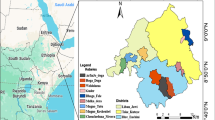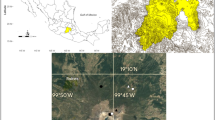Abstract
Livestock behaviour in the Pyrenees includes free grazing and a long resting period that provokes the accumulation of dung and urine in some places, so-called camping areas. The aims of this study were (i) to analyze any change in floral composition, and in nutritional and chemical contents of plants in a livestock camping area; and (ii) to relate the floral composition with soil chemical properties. In a linear transect, five sampling zones were established, from the centre of the camping area to the surrounding Nardus stricta-dominant pasture. The above ground plant biomass and the topsoil were sampled in each zone with 6 replicates per zone. Plant species were classified and weighed to calculate above ground biomass, nutritional and chemical contents, and Shannon diversity and evenness indices. Additionally, soils were sampled in two periods, at the beginning and at the end of grazing period. Soil available nutrients (nitrate, ammonium, phosphorus, potassium, calcium and magnesium), total nitrogen, organic carbon and pH were measured.
Plant chemical contents (protein, lignin and others) were significantly related to the proportions of grasses, legumes and other plants; so, the protein content is positively correlated with legumes plant biomass while lignin content is negatively correlated with grasses. Both plant and soil nutrients increased linearly towards the centre of the camping area. However, the relationship among plant species richness, diversity and evenness relative to its position along the studied transect was bell-shaped. From the outskirts to the centre of the camping area, plants with low nutrient demand were progressively replaced by those with medium and high nutrients demand and by pioneers.
Nardus stricta-dominant pasture has low plant diversity and plant nutrient content as well as a poor soil nutrient availability. The presence of the camping area introduced patches with more soil nutrients and new species in the large spatial scale. However at a small spatial scale, the strong soil nutrient concentration into the centre of the camping area reduced floral composition again. To ensure positive effects of camping areas on plant diversity, and to manage more effectively the nutrients returned to the soil, a reduction in the stocking rate should be pursued.
Similar content being viewed by others
References
Aldezábal, A., Garin, I. and García-González, R. 1999. Activity rhythms and the influence of some environmental variables on summer ungulate behaviour in Ordesa-Monte Perdido National Park. Pirineos 154: 145–157.
Amella, A. and Ferrer, C. 1990. Explotaciones de pastos en caseríos guipuzcoanos. Amalca Editorial. Guipuzkoa (In Spanish).
Ash, H. J., Bennet, R. and Scott, R. 1992. Flowers in the grass: creating and managing grasslands with wild flowers. English Nature. Peterborough.
Badía, D., Martí, C. and Terreros, J. 1994. Nutritional value of semi-arid pastures: influence of soil type and grass sowing. Agricoltura Mediterranea 124: 289–300.
Badía, D. and Martí, C. 1999. Suelos del Pirineo Central: Fragen. INIA. Pp. 1–190. (In Spanish).
Badía, D., García-González, R. and Martí, C. 2002. Clasificación de suelos en pastos alpinos de Aísa y Ordesa (Pirineo Central). Edafología 9: 11–22. (In Spanish).
Best, E. P. H. and Jacobs, F. H. H. 2001. Production, nutrient availability, and elemental balances of two meadows affected by different fertilization and water table regimes in the Netherlands. Plant Ecology 156: 61–73.
Braun-Blanquet, J. 1932. Plant Sociology. The study of plant communities. McGraw-Hill, New York.
Crawley, M. J. 1997. Plant-herbivore dynamics. In: Crawley, M. J. (eds.), Plant Ecology. Blackwell. Oxford. Pp. 401–474.
Duru, M., Colomb, B., Cransac, Y., Fardeau, J. C., Julien, J. L. and Roziere, M. 1996. Pedoclimat, fertilisation et croissance des prairies permanentes au printemps. Fourrages 133: 23–41. (In French).
Ellenberg, H. 1988. Vegetation Ecology of Central Europe. 4th edition. Cambridge University Press. UK.
García-González, R., Marinas, A., Gómez, D. and Aldezabal, A. 2002. Revisión bibliográfica de la producción primaria neta aérea de las principales comunidades pascícolas pirenaicas. In: Lleida University (eds.), Proceedings XLII Meeting of Spanish Society for the Study of Pastures. Lleida. Spain. Pp. 245–250. (In Spanish).
Gómez, D., Sesé, J. A. and Villar, L. 2003. The vegetation of the alpine zone in the Pyrenees. In: Nagy, L., et al. (eds.), Alpine biodiversity in Europe, Ecological Studies 167. Springer-Verlag, Heidelberg. Pp: 85–92.
Gómez, D., Mateo, G., Mercadal, N., Montserrat, P. and Sesé, J. A. 2007. Atlas digital de la Flora de Aragón. http://www.ipe.csic.es/floragon (accessed 5 July 2007). (In Spanish).
Grime, J. P. 1988. Comparative plant ecology: funtional approach to commun British species. Unwin Hyman. London.
Güsewell, S., Jewell, P. L. and Edwards, P. J. 2005. Effects of heterogeneous habitat use by cattle on nutrient availability and litter decomposition in soils of an Alpine pasture. Plant and Soil 268: 135–149.
Haynes, R. J. and Williams, P. H. 1999. Influences of stock camping behaviour on the soil microbiological and biochemical properties of grazed pastoral soils. Biology and Fertility of Soils 28: 253–258.
Janssens, F., Peeters, A., Tallowin, J. R. B., Bakker, J. P., Bekker, R. M., Fillat, F. and Oomes, M. J. M. 1998 Relationship between soil chemical factors and grassland diversity. Plant and Soil 202: 69–78.
Kaiser, H. F. and Caffrey, J. 1965. Alpha factor analysis. Psychometrika 30: 1–14.
Lowe, H.T., Matthew, C. and Mason, I.G. 1995. Effect of treated piggery effluent on pasture botanical composition, mineral content and yield. Agronomy Society of New Zealand. Proceedings Annual Conference 25: 35–41.
Maestro, M., Ferrer, C. and Broca, A. 2002. Presentación preliminar de resultados productivos y analíticos de recursos pascícolas de Aragón. In: Lleida University (eds.), Proceedings XLII Meeting of Spanish Society for the Study of Pastures. Lleida. Spain. Pp. 257–264. (In Spanish).
Magurran, A. E. 1989. Diversidad ecológica y su medición. Ed. Vedrá. Barcelona. Spain. (In Spanish).
McCrea, A.R., Trueman, I.C., Fullen, M. A., Atkinson, M.D. and Besenyei, L. 2001. Relationships between soil characteristics and species richness in two botanically heterogeneous created meadows in the urban English West Midlands. Biological Conservation 97: 171–180.
Montserrat, P. and Fillat, F. 1990. The systems of grassland management in Spain. In: Breymeyer, A. (Eds.), Managed grasslands. Elsevier. Amsterdam. Pp. 37–70.
Olff, H. and Ritchie, M. E. 1998. Effects of herbivores on grasslands plant diversity. Trends in Ecological Evolution 13(7): 261–265
Otal, C., Badía, D. and Fillat, F. 2005. Génesis y clasificación de una catena de suelos en pastos subalpinos de Linás de Broto (Pirineo Central). Georgica 11: 67–78. (In Spanish).
Page, A. L., Miller, R. H. and Keeney, D. R. 1982. Methods of soil analysis. Part 2: Chemical and microbiological properties, 2nd edition. American Society of Agronomy. Madison, Wisconsin.
Pessarakli, M. 1999. Handbook of plant and crop stress. 2nd edition. Marcel Dekker. New York.
Ritchie, M. E. and Olff, H. 1999. Herbivore diversity and plant dynamics: compensatory and additive effects. In: Olff, H. et al. (eds.). Herbivores: Between plants and predators. Blackwell. Oxford.
Santa-María, M., Chocarro, C., Aguirre J. and Fillat, F. 2003. Clasificación de los prados semiextensivos del Pirineo Central a partir de su composición florística. In: Junta de Andalucía (eds.), Proceedings XLIII Meeting of Spanish Society for the Study of Pastures. Pp. 593–599. (In Spanish).
SAS. 1998. SAS/STAT Software: Users’ Guide, Release 6.12. SAS Institute Inc. Cary, North Carolina.
Smit, A. and Kooijman, A. M. 2001. Impact of grazing on the input of organic matter and nutrients to the soil in a grass-encroached Scots pine forest. Forest Ecology Management 142: 99–107.
Soil Survey Staff. 2006. Keys to soil taxonomy. USDA. Natural Resources Conservation Service. USDA 10th edition. Washington. Pp. 1–332.
Somda, A. C., Powell, J. M. and Bationo, A. 1997. Soil pH and nitrogen changes following cattle and sheep urine deposition. Communications on Soil Science and Plant Analysis 28(15–16): 1253–1268.
Snow, C. S. R., Marrs, R. H. and Merrick, L. 1997. Trends in soil chemistry and floristic associated with the establishment of a low-input meadow system on an arable clay soil in Essex. Biological Conservation 79: 35–41.
Tabachnick, B. G. and Fidell, L. S. 1989. Using multivariate statistics. 2nd edition. Harper Collins Publishers, Inc. New York.
Van Groningen, J. W., Velthof, G. L., Van der Bolt, F. J. E., Vos, A. and Kuikman, P. J. 2005. Seasonal variation in NO2 emissions from urine patches: effects of urine concentration, soil compaction and dung. Plant and Soil 273: 15–27.
Van Soest, P. J. 1963. Use of detergents in the analysis of fibrous feeds. II. A rapid method for the determination of fibre and lignin. Journal of the Association of Official Agricultural Chemists 46: 829–835.
Winer, B. J., Brown, D. R. and Michels, K. M. 1991. Statistical principles in experimental design. 3rd edition. McGraw Hill. New York.
Author information
Authors and Affiliations
Corresponding author
Rights and permissions
About this article
Cite this article
Badía, D., Martí, C., Sánchez, J.R. et al. Influence of livestock soil eutrophication on floral composition in the Pyrenees mountains. J. Mt. Sci. 5, 63–72 (2008). https://doi.org/10.1007/s11629-008-0063-6
Received:
Accepted:
Published:
Issue Date:
DOI: https://doi.org/10.1007/s11629-008-0063-6




